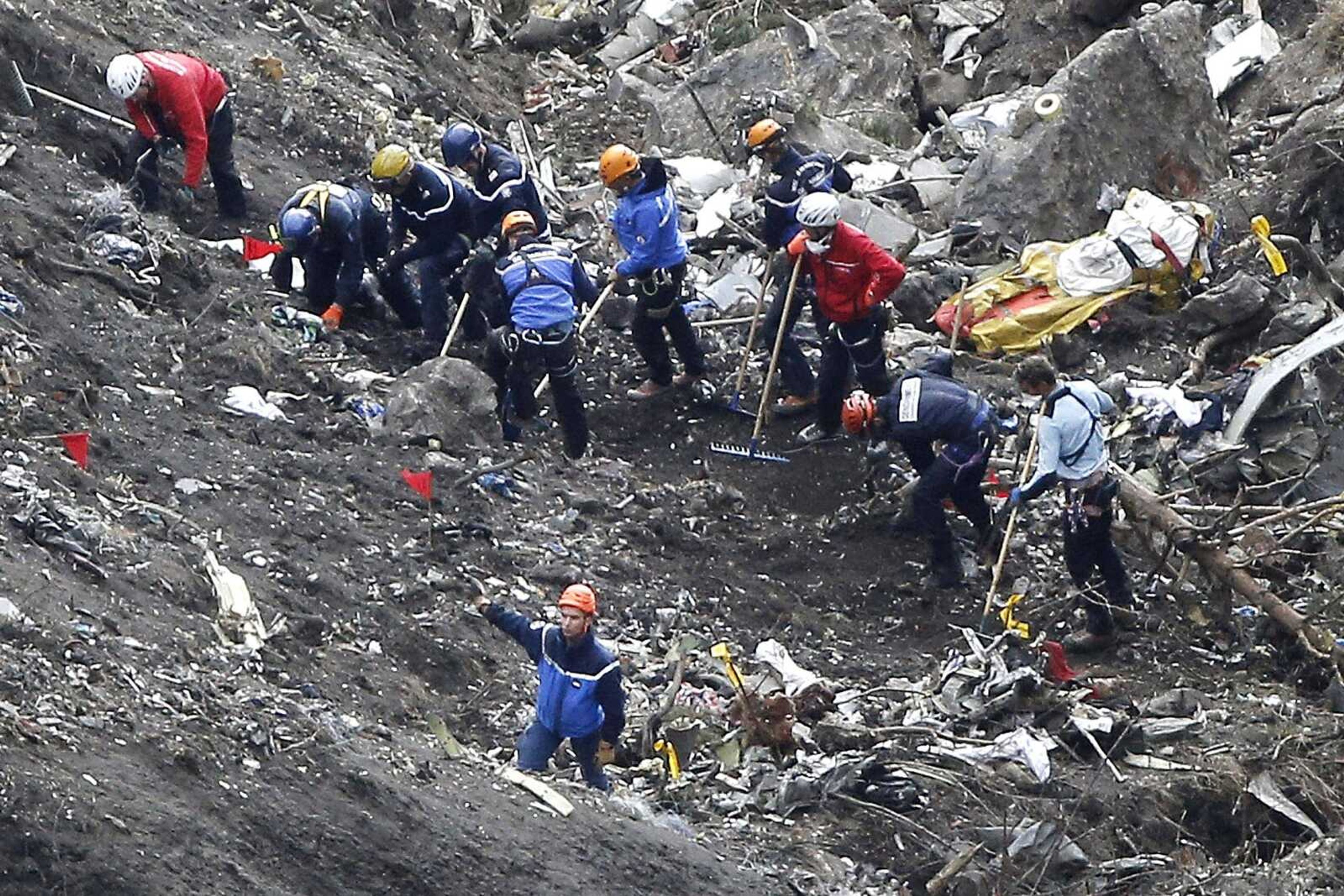Germanwings co-pilot tested descents before crash
PARIS -- A co-pilot who purposely crashed a Germanwings A320 plane into the French Alps appeared to have rehearsed sending the jet into a deadly descent on another flight two hours earlier, investigators said Wednesday. Authorities still are puzzling over why Andreas Lubitz, who had suffered from suicidal tendencies and depression in the past, locked the captain out of the cockpit March 24 and sent Flight 9525 from Barcelona to Duesseldorf straight into a mountain, killing all 150 people on board.. ...
PARIS -- A co-pilot who purposely crashed a Germanwings A320 plane into the French Alps appeared to have rehearsed sending the jet into a deadly descent on another flight two hours earlier, investigators said Wednesday.
Authorities still are puzzling over why Andreas Lubitz, who had suffered from suicidal tendencies and depression in the past, locked the captain out of the cockpit March 24 and sent Flight 9525 from Barcelona to Duesseldorf straight into a mountain, killing all 150 people on board.
The revelation about the earlier flight that day from Duesseldorf to Barcelona appeared to support the theory the Germanwings crash was not only deliberate but premeditated. It came in a 30-page interim report from the French accident investigation agency BEA.
The development also raised questions about all flights in which Lubitz was in the cockpit, but BEA said, due to practical considerations, it would not investigate those flights.
Lubitz seemed to toy with the airplane's settings on the flight into Barcelona, programming it for a sharp descent multiple times in a 4 1/2-minute period while the pilot was out of the cockpit before resetting the controls, the report said. Unlike the later flight, he did not lock the pilot out of the cockpit.

On the flight to Barcelona, the plane's "selected altitude" changed repeatedly and several times was set as low as 100 feet above sea level. The report says Lubitz also put the engines on idle, which gives the plane the ability to descend quickly.
On the return flight to Germany, Lubitz also set a 100-foot altitude before the plane crashed into the Alps.
Aviation experts say it would be unusual for a pilot to set a plane for such a low altitude repeatedly for no apparent reason. But the report said Lubitz did so while air traffic controllers were asking him to bring the airplane down gradually from 35,000 feet to 21,000 feet for its descent to Barcelona.
A BEA chart showed the plane didn't descend sharply while Lubitz repeatedly was adjusting the settings, so the passengers and crew might not have noticed any change.
"The captain didn't realize at all, because the co-pilot's tests during the outgoing flight took place during a normal, preprogrammed descent, and it never had an impact on the plane's trajectory," said Remi Jouty, director of BEA.
Aviation experts said the BEA findings were clearly unusual.
Lubitz changed the setting in the "altitude select" window, although the airplane didn't move in response to the inputs, said aviation safety expert John Cox, president of Safety Operating Systems.
"It's clear that it's a very unusual act," Cox said. "I've never seen it done, and it is the same methodology he used to fly the airplane into the ground. Was he practicing? I think that certainly is a possibility."
"He was practicing to see how the airplane behaved," said John Goglia, an aviation safety expert and former member of the U.S. National Transportation Safety Board.
Markus Wahl, spokesman of the German pilots' association, said Lubitz only could have done this when the other pilot was out of the cockpit.
"If there had been a pilot sitting next to him, of course he would have noticed that. Modern aircraft are built to be flown by two pilots, and one of the reasons for that is that one can watch the other," Wahl said.
Airlines typically download information from planes' flight data recorders for routine maintenance checks when the planes arrive at an airport where they plan to stay overnight.
But that data isn't monitored constantly, Goglia said. Even if Germanwings had done so, it probably would have taken a while to notice a problem -- or such odd readings might have dismissed such readings as an anomaly, he said. Many airlines have flight data monitoring programs to look for safety trends.
"They don't analyze every recorder every day for every minute it recorded," Goglia said.
"The lag time is about 30 days to analyze it," he said. "There is no urgency to this. The data goes into a data collection point and at some point somebody says, 'Let's look at the approaches into Barcelona."'
A BEA official said information from flight recorders is often erased, and is only systematically drawn upon in cases of air incidents or disasters.
"We're not going to verify whether he had tried to select 100 feet (altitudes) in other flights," BEA spokeswoman Martine del Bono told the AP. With the Barcelona-bound Germanwings flight data, "we have here the previous proof."
Germanwings "welcomed any new information that can help clarify what happened," but said it would not comment on the ongoing BEA investigation. It would also not comment on whether it was reviewing other flights involving Lubitz.
Lufthansa, the parent company of Germanwings, had no comment.
The BEA report didn't analyze why Lubitz repeatedly tried to descend the plane going into Barcelona. But the agency said it was continuing to look at "systemic failings that may have led to this accident or similar events."
The BEA investigators said they are focusing on "the current balance between medical confidentiality and flight safety" -- a reference to whether German rules on medical patient privacy may have prevented Lufthansa from being fully aware of Lubitz's mental health issues.
The agency is also looking at "compromises" made on security following the Sept. 11 attacks in the U.S., notably on cockpit door locking systems meant to protect pilots from terrorists. Since the Germanwings crash, several airlines have imposed rules requiring two people in the cockpit at all times.
It remains unclear why Lubitz would have wanted to crash the plane. German authorities say he researched suicide methods and cockpit door security online in the week before the crash.
Connect with the Southeast Missourian Newsroom:
For corrections to this story or other insights for the editor, click here. To submit a letter to the editor, click here. To learn about the Southeast Missourian’s AI Policy, click here.









